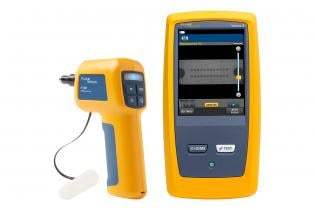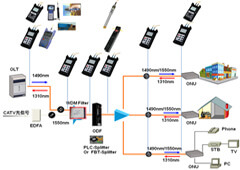Key features to look for when choosing fibre testing equipment
Wiki Article
Exploring the Impact of Robotic Vision on Modern Manufacturing Techniques and Quality Control
Robotic vision technology is transforming the landscape of contemporary production and quality assurance. By integrating sophisticated imaging systems and artificial knowledge, manufacturers can attain unprecedented degrees of accuracy and performance. This shift not only optimizes production procedures however likewise addresses essential challenges in maintaining item standards. As industries progressively count on these advancements, the implications for future production practices continue to be to be totally explored. What will this imply for the competitive characteristics of the marketplace?Understanding Robotic Vision Technology
Robotic vision modern technology serves as the backbone of automation in modern-day production. It encompasses making use of video cameras, sensing units, and expert system to enable robotics to interpret and reply to aesthetic info from their setting. This innovation permits robotics to identify, locate, and examine items, making them capable of performing complex tasks such as setting up, assessment, and material handling with accuracy. The combination of machine knowing algorithms additionally enhances the capability of robot vision systems, allowing them to adapt to differing conditions and boost over time. By processing pictures and information in real-time, robotic vision systems can assist in much faster decision-making and minimize mistakes in producing processes (optical fibre diameter analyser). This technology not only boosts functional efficiency but likewise assures that top quality standards are met constantly. As the production landscape remains to progress, comprehending the ins and outs of robotic vision innovation comes to be essential for leveraging its potential completelyBenefits of Robotic Vision in Production
Robotic vision innovation supplies considerable benefits in manufacturing by improving precision and precision in tasks such as quality control and assembly. This enhanced degree of information guarantees that products fulfill rigid criteria, reducing waste and remodel. Additionally, the assimilation of robot vision can result in increased production effectiveness, enabling suppliers to enhance their processes and achieve greater outcome prices.Improved Precision and Accuracy
In modern manufacturing, boosted precision and accuracy are essential for optimizing manufacturing procedures and making sure product high quality. Robotic vision systems allow machines to do intricate jobs with amazing consistency. These systems use sophisticated imaging modern technologies to find minute information and variations in materials, elements, and completed products. By evaluating visual information in real-time, robotic vision significantly reduces human error, bring about less problems and better requirements. In addition, enhanced accuracy in measurements and positioning facilitates better positioning in assembly procedures, which is vital for elaborate designs. Ultimately, the combination of robotic vision not only reinforces the integrity of making results but also cultivates self-confidence amongst consumers relating to product honesty and efficiency. This precision is crucial in sectors where quality is critical.Raised Manufacturing Efficiency

Producers are increasingly transforming to vision systems to enhance production effectiveness across various processes. These sophisticated systems make it possible for real-time examination and monitoring, substantially lowering downtime brought on by mistakes or defects. By incorporating robotic vision, business can automate quality control, permitting faster recognition of concerns and decreasing the demand for human intervention. This brings about streamlined operations, as robotics can rapidly adapt to adjustments in production needs without giving up accuracy. Additionally, vision systems facilitate much better inventory administration by precisely tracking parts and items, ensuring ideal source use. Inevitably, the adoption of robot vision not just boosts efficiency yet additionally adds to higher outcome prices, lowered functional prices, and improved general productivity in the manufacturing field.
Enhancing High Quality Control Processes
Robotic vision innovation considerably improves quality control processes in production by using accuracy examination techniques. These advanced systems promote real-time problem detection, making certain that items fulfill strict quality criteria. Because of this, producers can decrease waste and enhance total efficiency.Precision Inspection Techniques
Accuracy inspection methods have actually transformed quality assurance procedures in manufacturing, allowing the discovery of minute issues that traditional approaches may ignore. These methods take advantage of advanced imaging technologies, such as high-resolution cameras and laser scanning, to attain exceptional precision. By making use of robot vision systems, makers can automate examination jobs, guaranteeing regular performance and decreasing human error. The combination of maker knowing formulas in addition improves these systems, permitting them to adapt and enhance with time. On top of that, accuracy inspection facilitates the recognition of refined variants in product dimensions and surface coatings, which can substantially affect total item quality. Therefore, manufacturers can carry out corrective actions more promptly, inevitably resulting in minimized waste and improved client complete satisfaction.Real-Time Defect Detection
Taking advantage of advanced imaging technologies, real-time problem detection changes quality assurance procedures in manufacturing. By integrating high-resolution electronic cameras and innovative algorithms, manufacturers can quickly identify abnormalities during manufacturing. This modern technology promotes prompt restorative actions, decreasing waste and improving overall performance. Real-time systems assess items as they relocate along the production line, guaranteeing that defects are discovered and dealt with immediately production schedules. Furthermore, the application of artificial intelligence enhances the accuracy of these systems, allowing them to adjust to brand-new problem patterns gradually. Subsequently, manufacturers gain from enhanced product top quality and decreased operational prices. Inevitably, real-time problem detection not just enhances procedures however additionally promotes a culture of continuous enhancement in modern manufacturing atmospheres.Real-Time Data Evaluation and Decision Making
In the vibrant landscape of manufacturing, real-time data evaluation empowers systems to make swift, notified decisions. By leveraging sophisticated robotic vision modern technologies, manufacturers can collect and refine huge quantities of data instantly. These systems analyze visual inputs to keep track of manufacturing procedures, guaranteeing that any type of variances from quality standards are spotted and attended to immediately. As a result, producers can optimize procedures by reallocating sources and readjusting process based on real-time understandings.The combination of information analytics permits for anticipating upkeep, where prospective equipment failures are prepared for before they interrupt manufacturing. This aggressive method lessens downtime and boosts overall efficiency. optical measurement system. The capacity to make data-driven decisions in genuine time significantly lowers waste and enhances item quality, allowing manufacturers to respond to market needs quickly. Consequently, real-time data analysis not address only simplifies manufacturing but likewise promotes a society of continuous improvement in modern-day manufacturing atmospheres
Challenges in Applying Robotic Vision Solutions
Applying robotic vision systems in making presents a series of obstacles that can hinder their effectiveness. One considerable barrier is the complexity of integrating these systems with existing machinery and process. Producers frequently face compatibility issues with legacy equipment, bring about boosted expenses and downtime. Furthermore, the look what i found irregularity in item shapes, dimensions, and materials can make complex the calibration of vision systems, demanding comprehensive training and fine-tuning.An additional difficulty hinges on refining big quantities of visual information in genuine time. High-performance computer sources are important, which may need more investment in framework. Furthermore, there is a shortage of knowledgeable employees with the ability of managing and maintaining these advanced systems, bring about possible functional inefficiencies. Making certain the dependability and precision of robot vision systems under differing environmental problems presents a continual difficulty. Dealing with these concerns is vital for taking full advantage of the potential benefits of robot vision in production.
Future Patterns in Robotic Vision for Production
As over at this website developments in man-made knowledge and artificial intelligence proceed to evolve, the future of robotic vision in production shows up increasingly promising. Arising trends suggest a change towards extra innovative imaging technologies, such as 3D vision systems and hyperspectral imaging, which will improve precision in high quality control procedures. Integration with the Web of Points (IoT) will make it possible for real-time data analysis, allowing robot systems to adjust promptly to modifications in the production setting. The growth of collaborative robots (cobots) equipped with advanced vision capacities is expected to promote seamless human-robot interactions, boosting performance and safety on the manufacturing facility floor. Additionally, the incorporation of edge computer will equip robotic vision systems to process information locally, decreasing latency and allowing faster decision-making. These developments will not only improve producing processes but also greatly enhance product quality, placing robot vision as a cornerstone of future industrial operations.Regularly Asked Inquiries
Just How Much Does Robotic Vision Innovation Commonly Cost?
Robotic vision innovation generally sets you back in between $10,000 and $100,000, depending upon the complexity and specifications. Elements influencing rate consist of sensing unit high quality, software application capabilities, and assimilation needs, making it necessary to evaluate details project needs.What Industries Are Most Affected by Robotic Vision Advancements?
Robotic vision improvements significantly effect industries such as production, vehicle, electronics, and food handling - fibre testing equipment. These industries profit from improved automation, boosted quality assurance, and raised efficiency, leading to structured operations and decreased labor pricesCan Robotic Vision Systems Be Integrated With Existing Equipment?
Robotic vision systems can without a doubt be integrated with existing machinery. This combination boosts operational performance, enabling producers to leverage progressed technologies without the need for full overhauls, thus maximizing manufacturing procedures and preserving high quality criteria.
What Abilities Are Required to Operate Robotic Vision Equipments?
Running robot vision systems necessitates efficiency in programs, an understanding of artificial intelligence, knowledge of picture handling strategies, and the ability to repair software and hardware issues, making certain seamless assimilation and suitable efficiency within making atmospheres.Exist Any Safety And Security Worries With Robotic Vision in Manufacturing?

Report this wiki page